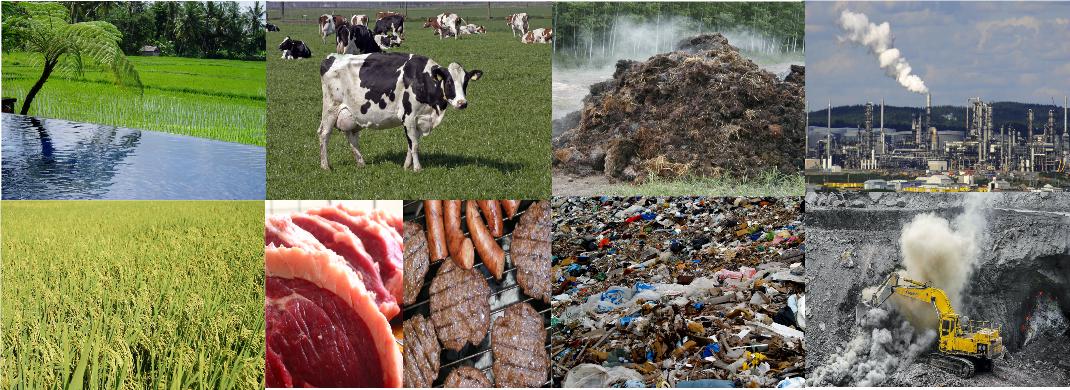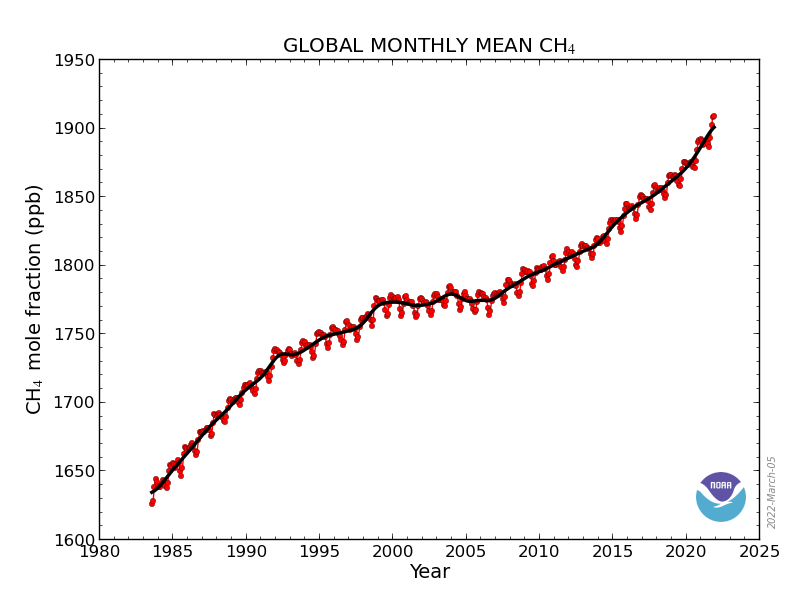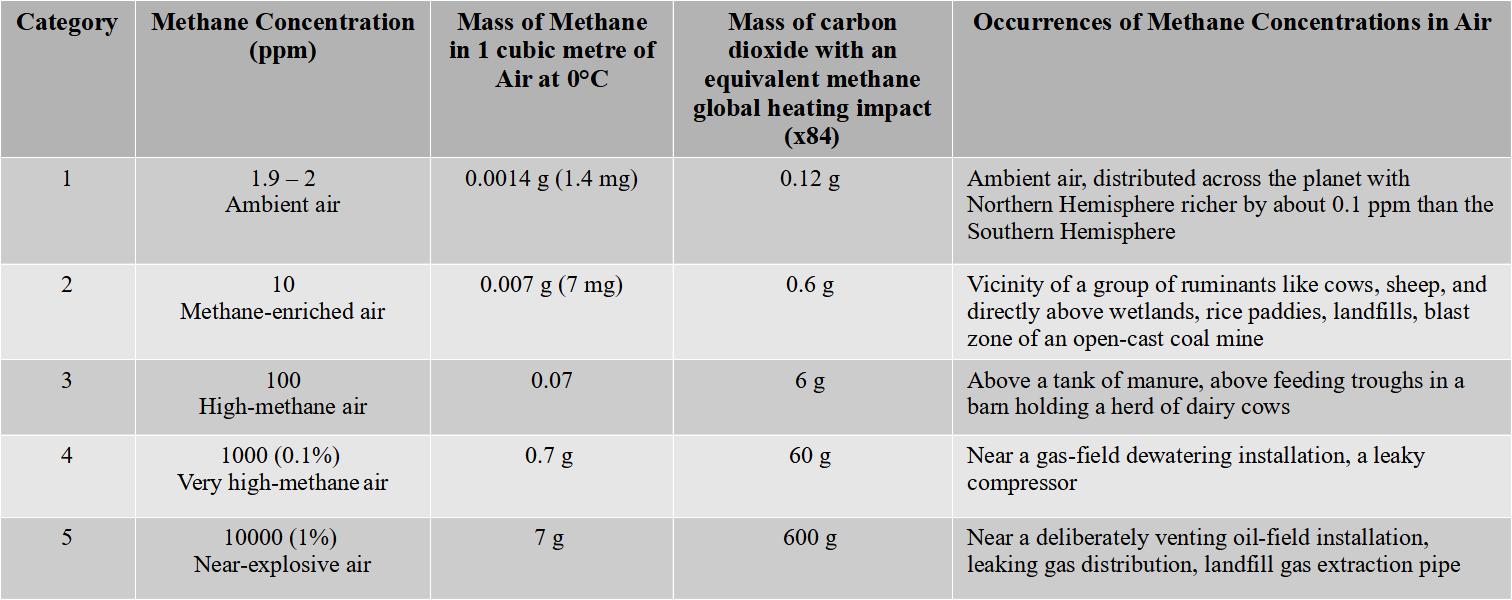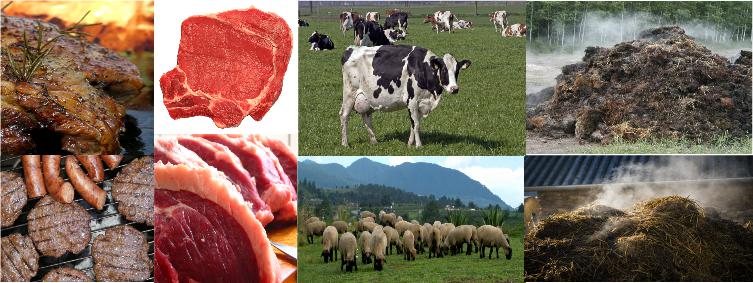Rapid robust response to anthropogenic methane emissions aims at prevention by positive behavioural changes, and equally targets elimination by hybrid removal of already emitted methane with its oxidative byproduct carbon dioxide. At more than 360 million tonnes of emissions per year, anthropogenic methane emissions contribute about 30 percent to the over 1 degree Celsius rise in global average temperature since industrialization, of which at least 0.3 degree Celsius can be subtracted off by end of 2030 through rapid robust response. Positive behavioural changes can reduce global methane concentration by over 30 percent within next decade through avoiding food waste and by consuming healthier plant-based and cell-cultured meat instead of the habitual eating of ruminant animals. And another 30 percent plus of reduction is attainable through hybrid removal by harvesting wasted methane and carbon dioxide with existing technologies for their valuable applications in creating renewable energy, clean water, food, chemicals, gemstones, and others.
Methane is second-largest greenhouse gas (GHG), after carbon dioxide, responsible for disrupting the natural cycle of climate and for causing the frequenting GHG emission-induced intense disasters. Both GHGs cause similar heating effects, but their concentrations and longevity in the atmosphere, number of emission sources and how often their emissions occur are different. Methane stays in the atmosphere for about one decade but traps heat many more times when compared to carbon dioxide which stays in the atmosphere for several decades into centuries. Over a 20-year period, every mass unit of methane in the atmosphere traps heat 84 times more than carbon dioxide. Anthropogenic methane emissions are not regular and mostly originate from a handful of industrial sectors, unlike the regular and continuous carbon dioxide emissions from almost all known industrial sectors.

Anthropogenic sources of methane emissions contribute over 360 million tonnes annually to the atmosphere, with about 40-50% originating from agriculture, 10-20% from waste management and 30-40% from energy sector (mainly coal mining, oil and natural gas explorations).
Based on data from Advanced Global Atmospheric Gases Experiment (AGAGE) and National Oceanic and Atmospheric Administration (NOAA), the air in 2021 has more than 1900 parts per billion of methane(1 part per billion (ppb) indicates that one out of every billion molecules in an air sample is methane). This is disturbingly more than twice the annual concentrations before industrialization in 18th century. It is currently estimated that the total global methaneemissions every year are about 596 million tonnes, of which about 232 million tonnes are emitted yearly from natural sources and about 364 million tonnes of methane are emitted each year from anthropogenic (human-related) activities. About half of these anthropogenic emissions stem from agriculture while rest of the emissions are distributed amongst coal mining, oil and gas exploration, and wastes management.

Graph showing globally-averaged, monthly mean atmospheric methane abundance, as measured since 1983 by Global Monitoring Division of NOAA’s Earth System Research Laboratory at a globally distributed network of air sampling sites.
Methane is naturally removed by chemical and biological processes, including oxidation reactions with atmospheric hydroxyl [OH] and chlorine, and by methane-consuming bacteria (methanotrophs) in soil and water. This is why methane stays about a decade in the atmosphere unlike carbon dioxide. Oxidative processes that remove methane usually produce carbon dioxide, which over a 20-year period causes the methane heating impact to be reduced by 99 percent, or by 97 percent over a 100-year period. The carbon dioxide byproduct is naturally consumed by plants, sinks into the oceans or absorbed in carbonate formations, but now it must also be removed by technologies as natural concentrations were exceeded.
The Intergovernmental Panel on Climate Change (IPCC) which is an organization of 195 government-members surmised in 2018 that the world has only a room for 570 billion tonnes of carbon dioxide to keep the global rising temperature below 1.5°C. But as the ecosystems get saturated with carbon dioxide absorption, some becoming new emitters instead of natural sinks, IPCC proposed that keeping global temperature from rising to 1.5°C requires attaining a target of more than 2 percent in annual reduction of methane emissions, with the aim to reach average reduction of 37 percent by 2030, below 2017 levels. At current annual carbon dioxide emission rate of more than 34 giga tonnes globally, there will be no room left in the atmosphere by the year 2035 to prevent global temperature reaching 1.5°C above pre-industrial levels. And at 1.5°C, which is the critical level beyond which disasters and their impacts rise exponentially, the world will be facing very intense and more frequent bombogenesis, tornadoes, hurricanes, flooding, inundations, snowstorms, drought and forest fires.
Some argue that the Sun must be partly responsible for the rising temperature but NASA satellite data since 1978 show slight drop in solar irradiance (a measure of the amount of energy emitted by the Sun), indicating that its changes have nothing to do with global heating. Hence, policy makers and stakeholders must rapidly respond to GHG emissions asmore methane become released by thawing permafrost in the Arctic region, which alone would be contributing 5-20 percent additional methane to the atmosphere, and would also be leaching unknown microbes into the environment. Concerted efforts to preventing methane emissions at their sources and removing already emitted methane are essential to fast-tracking the return of climate to its natural cycle, in order to stop the frequenting GHG emission-induced intense disasters. The imperative question to address now is whether the world will achieve a plus or a minus 0.3°C by 2030.
Emitters And Practical Solutions
About 232 [194-267] million tonnes per year of methaneare emitted from natural sources like wetlands, freshwater, oceans, termites, geological formations, permafrost soils and wild animals. Whereas, about 364 [340-381] million tonnesof methane emissions per year come from anthropogenic sources, which amount to 60 percent of total global methane emissions and of which more than 90 percent originate from these key industries: 40-50 percent from agriculture, 20-25 percent from oil and gas, 10-15 percent from coal mining, 7-10 percent from solidwaste management, and 7-10 percent from wastewater. In the past 20 years alone, these sectors of industrial activities have caused more than 25 percent rise in methane emissions.
However, by the end of this decade these same industries can achieve more than 40 percent reduction in global methane emissions per annum. This can only happen if each of these sectors is strongly bound to rapid implementation of robust preventive and removal actions. That calls for the government, industries and all stakeholders to invest more efforts in improving and increasing high-precision monitoring and data collection of methane emissions, with lasers, infrared cameras, sensors, drones and satellites. Their costs are not expensive. Portable and on-board automated analytical, reporting and verification techniques are also imperative in order to replace estimations and bias with real-time identification, observed measurements and zero error margins.
Concentrations (ppm, grams) and occurrences of methane in one cubic metre of air at zero degrees Celsius with equivalent mass of carbon dioxide that creates same global heating impact over a 20-year

Oil and Gas Industry
Emissions: About 20-25 percent of anthropogenic methane emissions stem from oil and gas industry, which emits about 84 [72–97] million tonnes of fugitive methane through venting, leaks, and incomplete combustion during flaring. When methane gas escapes from industrial equipment and other processes where it ought to be contained, due to leaks or other unexpected escapes, the resulting emissions are called fugitive. Methane emissions from oil and gas explorations as well as from coal mining constitute the bulk of emissions from fossil fuel sector. About 7 million tonnes of methane emissions per year are contributed by some manufacturing industry and transport, which constitute less than 2 percent of anthropogenic emissions.
Emissions Prevention: Natural gas is composed mostly of methane. Oil and gas companies can prevent methane emissions by installation of: vapour recovery systems (VRU), modernized air systems, double mechanical seals on pumps, dry gas seals on compressors, carbon packing ring sets on valve stems as well as distributed units of micro-nano sensors for leak detection and repair (LDAR). Non-routine flaring can be eradicated by use of artificial intelligence (AI) to conduct regular and high reliability predictive maintenance in addition to replacement of equipment and valve seals. There are many consumer products that need direct utilization of methane as feedstock for their production, and hence demand capturing methane best before escape to the atmosphere.
Emitted Methane Removal: Already emitted methane can be extracted out from the air by using industrially well-established technique of gas separation membranes. This can be installed easily and scaled up many-folds by every oil and gas industry to remove mega tonnes of methane annually from the environment. Zeolites are microporous aluminosilicate minerals often used as off-the-shelf commercial adsorbents and catalysts. Fans can be used to direct air into zeolite beds or into columned zeolites where air molecular components are adsorbed and scrubbed out from air with the remaining concentrated methanerouted for utilization in the downstream sectors, factories, and in production of renewable energy. It is also possible to use a combination of zeolith powder and copper catalyst for the bed or column and then heat at 300 degree Celsius to trap and convert methane into carbon dioxide, which must then be captured for use.
Implementation Benefits: Upon implementing abatement measures, oil and gas industry could achieve 25-35 percent reduction in sectoral methane emissions by 2030 and a 73 percent reduction by 2050. Up to 80 percent of oil and gas measures could be implemented at negative or low cost to reduce emissions by 29–57 million tonnes every year by 2030. McKinsey has earlier estimated that reducing fugitive emissions and flaring could contribute 1.5 giga tonnes carbon dioxide equivalent (GtCO2e) to annual abatement by 2050, at a cost of less than 15 US dollars per tCO2e.
Based on International Energy Agency (IEA) global methane emissions data for energy sector in 2021, emissions from bioenergy were 9.1 million tonnes, coal were 43.6 million tonnes, natural gas were 39.6 million tonnes and oil were 42.9 million tonnes. If these 135.2 million tonnes of methane emitted in 2021 alone were captured and marketed, these would have amounted to all the gas used in Europe’s power sector, and would have cushioned the impacts of gas shortages which have intensified pressure on end-consumer prices with the collapse of many energy supplying companies.

Methane emissions from oil and natural gas explorations as well as coal mining contribute over 125 million tonnes of methane annually to the atmosphere. In 2021, 135.2 million tonnes of methane emissions were recorded for the energy sector, including bioenergy industry.
Coal Mining
Emissions: About 10-15 percent of anthropogenic methane emissions are from coal mining industry which emits around44 [31–63] million tonnes of coal-mine-methane (CMM) per year from active and abandoned deep mines. CMM is gas trapped in coal seams, which has a chemical composition of 70 percent methane, 15 percent carbon dioxide and 15 percent nitrogen. The gas is released when seams are mined, and then escapes to the atmosphere. China accounts for more than 75 percent of CMM emissions.
Emissions Prevention: CMM can be recovered from coal mining sites before they escape out through vertical and horizontal wells or boreholes. CMM can also be recovered from abandoned mines, which may continue to emit methane from diffuse vents or ventilation pipes or boreholes. Proactive prevention of methane emissions can also be done by targeting coal bed methane (CBM) gas which can be extracted from deep unmined coal seams by injecting carbon dioxide into the seam so that it displaces the methane. Captured CMM can be recycled for electrical and thermal power generation or be utilized in production of commodities.
The most effective way to prevent CMM emissions is by avoiding the use of coal. China and other coal-dependent countries can divest resources into capturing CMM from their abandoned coal mines, which continue CMM emissions many years after closure. The safety practice of draining explosive methanefrom coal mines before commencement of mining can be taken advantage of, by capturing the drained CMM without taking the next step of active mining. Captured CMM can satisfy the electricity and heating needs that are the primary motives for coal mining.
Emitted Methane Removal: Preventing CMM emissions from coal mining reduces further inundation of the atmosphere with new anthropogenic methane. At a threatening concentration of 1900 parts per billion in air, methaneremoval is a sure pathway to expedite the threat mitigation. Extracting out methane from air can be achieved in the coal sector by installing and using existing technique of gas separation membranes, which can be combined with methane concentrators where molecular sieves adsorb oxygen, carbon dioxide and nitrogenonto zeolites to scrub them out from the air such that the remaining methane is concentrated, and then can be utilized in production of renewable energy and commodities.
Implementation Benefits: Coal mining industry could achieve 4-7 percent reduction in sectoral methane emissions by 2030 and a 13 percent reduction by 2050 if abatement measures are executed. About 98 percent of the measures could be implemented at negative or low cost to reduce emissions by 12-25 million tonnes every year by 2030.
Agriculture

About 70% of over 160 million tonnes methane emitted annually from agricultural sector are from ruminants, which are farmed mostly for their meats and dairy products.
Emissions: About 40-50 percent of anthropogenic methane emissions originate from the agricultural industry, which emits methane through biomass burning (about 16 [11–24] million tonnes per year), production of rice (about 30 [24–40] million tonnes per year) and farming of ruminant animals like cows, goats and sheep (about 115 [110–121] million tonnes per year).
Almost 70 percent of methane emissions from agricultural sector are from ruminants’ food digestion, particularly enteric fermentation, which is their digestive process of converting sugars to simple molecules for absorption into their bloodstream, with methane produced as a by-product. Cow belching due to this enteric fermentation is a bigger methanesource when compared to cow flatulence, involving release of small percentage of methane produced in the cow’s large intestine. Enteric fermentation and manure management represent about 32 percent of global anthropogenic emissions. Settling ponds and lagoons for processing manure release huge amounts of methane.
Another source of methane emission in this sector is biomass burning caused by land expansion for pasture and crops cultivation. Biomass burning has a mixture of anthropogenic and natural causes, and the use of biofuels are relatively insignificant sources of methane emissions. Agricultural waste burning together with biofuels contributes about 1 to 3 million tonnes per year in methane emissions, 1 percent or less of global anthropogenic emissions. Mechanical flooding used to manage pests in rice farming is another doorway to methane releases, adding another 8 percent to anthropogenic emissions.
Emissions Prevention: Behavioral change is the most important prevention pathway in this sector. It could substantially reduce the over-dependence on consumption of ruminants flesh meat, which has been driving the motivation for their large-scale farming. Feed additives is a viable but a secondary approach for preventing methane emissions, especially from cow belching and farting.
Deployment of modern farming methods and artificial intelligence (AI) facilitated technologies to manage rice production and land expansion is another way to prevent methane emissions. Use of dry seeding is advocated to reduce methane emissions from the mechanical flooding, but dry seeding could lead to rise in emissions of nitrous oxide, which is another highly potent GHG.
Ruminant dungs and manures can be collected into sealed biodigesters to purposefully make biogas, which can be captured by inserting gas draining pipes. The collected biogas can then be used in the generation of electricity and heating. Using photocatalytic oxidation where ultraviolet light from sunlight oxidizes methane into carbon dioxide is another alternative way to prevent methane emissions into the atmosphere. Ultraviolet light splits an oxygen molecule into two free radicals, which then react with emitted methanefrom the dungs and manures to produce carbon dioxide. This oxidative preventive measure is a slow process but can be easily used by local farmers at no cost.
Another preventive approach is the use of zeolite, which is well-known for its smell and liquid absorption in domesticating animals. Heating a combination of zeolith powder with copper catalyst at 50-300 degrees Celsius traps and converts methane into carbon dioxide.
Emitted Methane Removal: In facilities where manure is collected as a slurry in anaerobic pipes and tanks, installation of gas separation membranes and zeolite-based extraction can be used to remove methane from the methane-rich air around the slurry facilities. It is as simple as using fans to direct air to flow through separation membranes and/or zeolith. Methane can be collected as biogas for independent generation of electricity and heating to meet all farming energy needs, which can also serve the purpose of 300°C heating of zeolith/copper mixture to eliminate many more tonnes of atmospheric methane by converting methane into carbon dioxide.
Implementation Benefits: The agricultural industry could achieve 10-30 percent reduction in sectoral methane emissions by 2030 and over 30 percent reduction by 2050. Implemented agricultural sector measures could reduce emissions by more than 75 million tonnes every year by 2030. Methaneemissions from rice cultivation could be reduced by 6–9 million tonnes every year by 2030, while emissions from livestock can be mitigated by 4–42 million tonnes every year by 2030. Behavioural change measures like cutting down on food wastes and loss, upgrading livestock management, and adopting meatless diets could reduce methane emissions by over 65–80 million tonnes every year.
Solid Waste Management
Emissions: About 5-10 percent anthropogenic methane emissions are produced by the solid-waste management industry, which emits bio-methane from anaerobically digested organic materials in landfills and open waste dumps. Bio-methane is a natural gas that does not originate from fossils.
Emissions Prevention: Biogas can be captured before escaping into the atmosphere, and this can be done with established technologies like using ventilation pipes or boreholes at landfill sites. Improved treatments before disposal of solid wastes using chemical and biological methods to oxidize methane into carbon dioxide prevents methane emissions. Soil covers that have been seeded with highly efficient aerobic methanotrophs can also be added to solidwastes in order to consume and oxidize methane into carbon dioxide. However, these approaches demand that plans to remove and use the converted carbon dioxide must be in place to mitigate against the problem of solving methane emission by creating carbon dioxide emission.
Emitted Methane Removal: In open dumps and landfills, installation of gas separation membranes technique and zeolite-based extraction can be used to extract methane from the methane-rich air surrounding the active face of the waste sites.
Implementation Benefits: Preventive and removal measures implemented by solid waste management could lead to 30-40 percent reduction in sectoral methane emissions by 2030 and a 91 percent reduction by 2050. About 60 percent of solid waste measures could be implemented at negative or low cost to reduce emissions by 29-36 million tonnes every year by 2030.
Wastewater Management
Emissions: About 5-10 percent anthropogenic methane emissions originate from wastewater sector, which emits bio-methane from anaerobically digested organic materials in wastewater effluents. Both solidwastes and wastewater emit about 68 [64–71] million tonnes of methane per year.
Emissions Prevention: Cascaded filters or sieves of micro-nano sized pores can be used to remove organic solid materials in wastewater to prevent anaerobic digestion that causes methane formation. This approach can be further combined with the use of microalgae in the final wastewater to guarantee that no methane is formed. Soils seeded with highly efficient aerobic methanotrophs can be added to consume and oxidize methane into carbon dioxide for removal. In scenarios where solid filtering or use of microalgae and methanotrophs are not possible, installing pipes or boreholes at wastewater sites would enable biogas to be captured before escaping into the atmosphere. Captured biogas can then be utilized as feedstock in the production of green commodities.
Emitted Methane Removal: Installation of gas separation membranes and zeolite-based extraction can be used to remove methane from the methane-rich air around the active face of wastewaters.
Implementation Benefits: Preventive and removal measures implemented by wastewater management could lead to 25-30 percent reduction in sectoral methane emissions by 2030 and a 77 percent reduction by 2050. Up to 60 percent of wastewater measures could be implemented at negative or low cost to reduce emissions by 29-36 million tonnes every year by 2030.
2022 and Beyond
Accelerating Global Robust Response
Priority Target Sector Agriculture: Too much dependence on large scale farming of ruminant animals for their meat consumption contributes about 115 million tonnes of methaneemissions per year, which is around 70 percent of agricultural sector emissions and 32 percent of global emissions every year. Behavioural shift towards consumption of plant-based meat will curb these particular emissions, even though less than 20 percent of flesh meat eaters would currently adopt plant based meat. NOVAMEAT has reorganized nanofibers from vegetables’ proteins to make them seem like animal proteins and has achieved a 3D printed pork, with ongoing introduction of steak and other flavours. These are all suitable for flesh meat eaters who would choose to adapt to clean healthier non-emitting methane sourced meat without loosing the taste and texture of their favourite meat.
But there is also another appealing alternative for animals’ meat eaters which would drastically reduce farming of ruminants and in turn cut down global emissions. This is the 3D printing of meat from established methods that mimic the natural process of muscle-regeneration occurring inside ruminants. Aleph Farms is already implementing this approach by using bovine cells to replicate the taste, texture and sight of meat. This alternative is perfect for meat eaters who persist on consuming meat for the sake of animal flesh, but it is also suitable for non-meat eaters who avoid meat because of animal killing and other ethical, cultural or religious reasons.

Behavioural changes that involve substituting consumption of ruminants’ flesh meat with eating of plant-based and cell-cultivated meat would shave off over 30 percent of global methane emissions each year, since more than 110 million tonnes of methane emitted annually are from large-scale farmed ruminants.
Rapid scaling up of 3D meat printing to global capacity is imperative, like MeaTech is doing. Individuals, families and communities can acquire 3D bioprinters with ease and at affordable cost to develop and print their own varieties of plant-based or cell-cultured meat. All these would go hand-in-hand with the objective of cutting down over half of the 32 percent of global annual emissions from ruminants by 2030.
Priority Target Sector Energy - Oil, Natural Gas and Coal: Addressing the 40 percent of anthropogenic methane emissions originating from energy sector is an opportunity to rapidly stop global rise in temperatures because robust approaches for preventing methane emissions and for removing emitted methane in this sector are already in existence and established, can be quickly scaled up and are inexpensive, with global net negative emissions feasible by the year 2050. That is, targeting to curb methane emissions from this energy sector is one of the shortest route to ‘buy the world more time’ to mitigate against the frequenting GHG emission-induced intense disasters.
Methane emitted from these energy industries can be removed by extraction from air using well-established gas separation or zeolith-based techniques at low cost. Electrical and thermal power can be produced at very cheap pricing by using captured methane. The year 2021 recorded 135.2 million tonnes of methane emissions from the energy sector alone, which according to IEA would have amounted to all the gas used in Europe’s power sector. At a methane concentration of over 1900 ppb in air, there is more than enough methane to satisfy the global energy needs at affordable prices without any energy crisis.

Escaping methane can be captured using pipes/boreholes, and used to create renewable energy like in Rolls-Royce’s combined heat and power (CHP, centre image) to meet industrial and household demands at low costs.
Global Financial Cost: If stakeholders invest efforts to fully implement abatement measures for methane emissions, McKinsey estimated that this will amount to about 3.3-5.1 trillion US dollars over a 30-year period, with at least an achievement of 55 percent global reduction in methane emissions by 2050. United Nations Environment Programme (UNEP) and Climate and Clean Air Coalition (CCAC) estimated implementation of all-cost measures for methane abatement to be about 600 US dollars per tonne of methane, which would correspond to about 7 US dollars per tonne of carbon dioxide equivalent when converted using the 20-year period of methane-to-carbon dioxide heating impact of 84. Both organizations assessed that the global monetized benefits for all market and non-market impacts are approximately 4300 US dollars per tonne of methane reduced.
It is apparent that a rapid robust response to anthropogenic methane emissions would not be cost intensive but instead would be a stable source of revenue for industries that pursue implementation in order to decelerate the frequenting GHG emission-induced intense disasters. The measures pay for themselves rapidly, with oil and gas sector top on list to achieve negative cost abatement.
Global Gain: A Global Methane Assessment in 2021 postulated that anthropogenic methane emissions can be curbed by up to 45 percent, or around 180 million tonnes a year by 2030. The reductions could remove 0.3°C off the rising global temperatures by 2040s and would keep the Paris Climate Agreement’s goal to limit global temperature rise to 1.5˚C. With a sense of urgency, it is feasible with existing technologies to remove 0.3°C off the rising global temperatures by 2030.
According to the UNEP and CCAC assessment, since methane is a main component in the formation of ground-level ozone (smog), which is a powerful 'climate forcer' and dangerous air pollutant, curbing of methane emissions by 180 million tonnes a year by 2030 would prevent 255,000 premature deaths, 755,000 asthma-related hospital visits, 73 billion hours of lost labour from extreme heat, and 26 million tonnes of crop losses annually. It concluded that the world will be gaining about 450 billion US dollars per year for avoiding premature deaths every year if prevention and removal of anthropogenic methane emissions are implemented to stay below 1.5°C.

Graphs (top) showing concentrations of methane and carbon dioxide in the atmosphere. Graph (below) depicts rising global temperature anomalies for over a century.
Hybrid Removal of Emitted Methane and Carbon Dioxide
Methane stays in atmosphere for about one decade as it is naturally converted into carbon dioxide by hydroxyl radicals oxidative reactions. Over a 20-year period, removing 1 gram of methane is equivalent to removing more than 84 grams of carbon dioxide and over a 100-year period, removing 1 gram of methane is equivalent to removing more than 32 grams of carbon dioxide. This is why a rapid robust response to anthropogenic methane emissions is imperative to keep global heating below 1.5 degrees. However, priority to rapidly tackle methane emissions does not mean a low preference to addressing emissions of carbon dioxide, but instead it is an effort to delay impending intense disasters in order to develop large scale carbon dioxide removal and utilization systems, in giga tonnes per year.
About half of the light reaching the atmosphere passes through air and clouds to be absorbed by the surface. This is then radiated back as infrared heat upward to the atmosphere, with about 90 percent of this heat absorbed by carbon dioxide, methane and other greenhouse gases. This is again radiated back as heat downward to the surface. Carbon dioxide is more dense than methane,and consequently sits mostly in the troposphere or lower atmosphere where it effectively traps any heat radiated from the surface below. Carbon dioxide derived from hydroxyl radical oxidation of methane in the stratosphere or upper atmosphere drops to the troposphere and adds to the carbon dioxide population accumulating there from emissions.
Because the atmosphere is inundated by anthropogenic methaneemissions, the methane populationin the troposphere and stratosphere have increased beyond normal natural level as evidenced by its rise of 10-17 percent in the stratosphere between 1978 and 2003, whereas concentration of hydroxyl radicals decreased. This growing situation presents a big challenge that cannot be imagined given that the lifetime of methane starts extending above one decade into several decades and even beyond a century if it is not naturally oxidized by hydroxyl radicals or removed by artificial ways.
Atmospheric concentrations of carbon dioxide have unnaturally increased steadily to 49 percent from 280 parts per million (ppm) to about today’s 418 parts per million (ppm) in just about 200 years. The world has only a room for 570 billion tonnes carbon dioxide to keep the global rising temperature below 1.5°C, and this room will be exhausted in the 2030s, before the year 2040, as more than 30 giga tonnes of anthropogenic carbon dioxide inundates the atmosphere every year. Already, the acidity of surface ocean waters has increased by about 30 percent since the dawn of industrialization, and more than normal amount of carbon dioxide has been absorbed into the ocean, at about 20-30 percent of total anthropogenic carbon dioxide emissions in the last few decades, at 7-11 billion tonnes per year.
With today’s concentration of carbon dioxide in the atmosphere (>400 ppm) at over 200 times more than the concentration of methane (≈2 ppm), it then implies that the overall heat trapping effect with frequenting GHG emission-induced intense disasters is generally piloted by overpopulation of carbon dioxide. Consequently, hybrid or combined removals of anthropogenic carbon dioxide and methaneemissions would solve the dilemma that some techniques for curbing methane emissions, in particular oxidative methods, end up producing carbon dioxide. Hence, any removal or destruction of methane that results in carbon dioxide emissions requires an installation of a carbon dioxide point-source or direct air capture (DAC) system. And of course with many valuable uses of captured carbon dioxide and methane, both GHGs ought to be seen as treasures to be hunted and to be turned into assets of end-to-end value chain, such as in the production of renewable energy, synthetic fuels, chemicals, clean water, gemstones, pharmaceuticals, food, and many others.
Technologies for removing both carbon dioxide and methane are already established in the market. Like in methane removal, point-source technologies remove carbon dioxide straight from a specific emission source whereas DAC which is an open-source system removes carbon dioxide straight from the atmosphere. There is the liquid DAC systems that channel air to pass through a chemical solution, removing the carbon dioxide before expelling clean air back into the atmosphere. And there is the solid DAC systems which use solid sorbent filters that chemically bind carbon dioxide particles from air and then release the concentrated carbon dioxide for utilization by stimulating the sorbent via heating, change of pressure or microwaves.
The DAC choice to use depends on affordability and ease of integration with deployed methane removal system. Today, Climeworks’ ORCA (4000 tonnes/year capacity), Carbon Engineering (1 million tonnes/year capacity) and MitsibushiKS-21/Drax (8 million tonnes/year) are promising large-scale carbon dioxide removal units that can work in tandem with methane removal technologies to form hybrid removal systems as part of a rapid robust response strategy.


